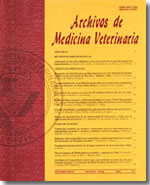The effect of diets with different protein/lipid ratios on productive performance and carcass characteristics of the Pacific salmon (Oncorhynchus kisutch)
Main Article Content
Abstract
The objective of the present study was to evaluate the productive performance, carcass characteristics and the food cost of each kg body weight gained per salmon fed with different proportions of protein/lipid in their diet during their final fattening period (P/L). Three thousand and three hundred coho salmons were randomly assigned to three diets with two repetitions each. The fishes of the first group were fed a diet with 45% of protein and 22% of lipids (P/L 2.04) (control). The second group received a diet with 43% protein 26% lipids diet (P/L 1.65), and the third group a diet with 40% protein 30% lipids diet (P/L 1.33). The productive performance was evaluated taking into account the feed consumption, weight gain, feed conversion efficiency, specific growth rate and average final weight. The characteristics quality were evaluated considering body length, condition factor, eviscerated weight, carcass yield, viscera weight, liver weight, gonad weights, perivisceral fat and belly thickness.
The productive performance results were similar between all treatments except the average weight. This value was higher in the treatments with lower P/L ratios (p<0.05); diet 1: 3911g; diet 2: 4179g and diet 3: 4078g and males (4237g) were heavier (p<0.05) than females (3840g). In general, the better carcass characteristics in fish were obtained by fishes fed diet 2 compared with those fed diet 1 but with fishes fed diet 3, and males had a better performance than females. Diets with more fat produced greater perivisceral fat content however the carcass yield was not affected. The diet 2 ($675) turned out to be of a greater cost for each kg gained than the diet 1($ 627) and diet 3 ($ 625). The final decision of feeding a diet with a higher lipid content has to be based on a better feed conversion efficiency and that the substitution of an ingredient, such as fish meal, should be a diet of a lower price, that was not observed in this assay.

